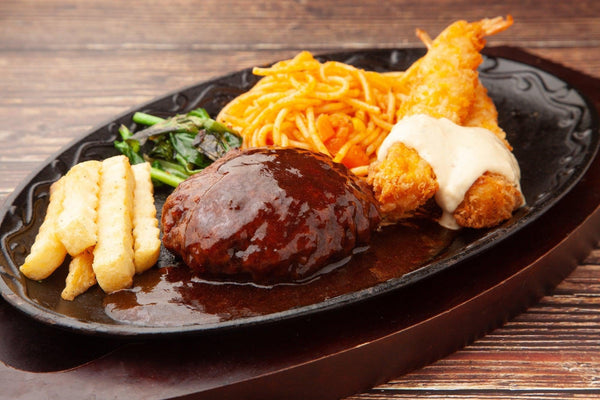
Jump to:
Among the varied food genres in Japan, one with which many visitors may not be initially familiar – and yet somehow find familiarity in – is Yoshoku.
Translated as "Western food," Yoshoku comprises a wide swath of cuisine in Japan, seen across a variety of dishes and flavors. The one thing that these dishes and styles have in common is that their origins are from beyond Japan’s borders. And yet Yoshoku itself is a distinctly Japanese creation, one of the most popular Japanese foods nowadays.
Yoshoku is seen in such forms as curry rice, spaghetti napolitan, hambagu (hamburg steak), omurice, doria, korokke and many other favorites. It is regularly featured across the food spectrum in Japan, from home-cooked comfort food and humble mom-and-pop restaurants to mid-market and higher-end restaurants (even some establishments in the vaunted Michelin Guide) featuring their own versions of Yoshoku favorites.
It’s time to shine the spotlight on the ever-popular Yoshoku. Join us as we trace its fascinating history & evolution and savor some of the many delicious permutations of well-known Yoshoku that have become an integral part of Japan's modern-day culinary scene.
Origins And Evolution Of Yoshoku As A Japanese Culinary Style

The roots of Yoshoku can be traced back to the late 19th century when Japan underwent a period of rapid modernization and westernization.
Yoshoku, or "Western dishes," first appeared as a culinary phenomenon during Japan's Meiji era (1868–1912). This period marked a significant turning point for Japan as it opened its doors to the world, embracing Western influences in various aspects of life, including cuisine.
The Meiji government encouraged the adoption of Western technologies and practices, leading to a culinary revolution. Yoshoku was born out of a desire to incorporate western dishes into the Japanese palate while adapting them to local preferences.
The first Yoshoku dishes were introduced in upscale restaurants and hotels. These were new national dishes of Japan for the privileged, not for the masses. Curry and tonkatsu, for example, were hardly something one would make at home or find in a local cafeteria during that time.
Yoshoku Then & Now
Yoshoku’s roots were largely seen as being luxurious, a treat for those with means. Western dishes, after all, were something most Japanese could only hear or dream about.
Over time, however, Yoshoku has become a genre enjoyed by people of all walks of life in Japan. Indeed, Yoshoku is often synonymous with “comfort food” in Japan nowadays, especially with dishes such as curry rice, Napolitan, hayashi rice and others.
Yoshoku has made a transformation from a food for elites to a food for the masses. In fact, you could say it’s really come full circle now, as elevated Yoshoku restaurants are appearing more and more on the Japanese food scene.
If you’re out and about on your travels in Japan and find yourself looking for a Japanese lunch, you can’t go wrong with Yoshoku – it’s everywhere, especially at midday.
With the history and evolution understood, let’s dig in and explore some of the popular Yoshoku foods enjoyed in Japan (and in Japanese restaurants around the world) nowadays.
Kare Raisu (Curry Rice)

One iconic example is the introduction of "curry rice" (kare raisu), a dish that originated in British-ruled colonial India but underwent a transformation in Japan.
A cornerstone of Yoshoku, Japanese curry rice has become a beloved comfort food. While it might not be called the national dish of Japan, it’s certainly the national Yoshoku dish of Japan.
Perhaps you’re thinking, “hey, curry, that’s Indian – not western!” Well, you wouldn’t be wrong. Of course, curry comes from India originally. The introduction of curry in Japan, however, is widely attributed to the British. As the story goes, British sailors arrived in Japan with curry powder, and Japan’s Navy found a way to utilize the new spices to create dishes with economy and sustenance in mind.
Japanese curry is thicker and sweeter than its Indian counterpart, featuring a rich, savory sauce poured over rice. This adaptation reflects the Japanese inclination toward milder flavors and the desire for a heartier, comforting dish. The curry roux – a thickened mixture of flour, oil, and curry spices – is the soul of this dish. It often includes ingredients like potatoes, carrots, and meat, creating a wholesome and satisfying meal.
While it’s common for Japanese people to make curry rice at home, it can also be enjoyed in local restaurants and even national curry rice chains (such as Coco Ichibanya). Kids love curry; so do single people, couples, families, older folks and more. Curry is a must-try for visitors or those looking to cook popular Japanese foods at home.
Omurice (Omelet Rice)

Omurice is a fusion of Western omelets and Japanese fried rice.
A fluffy omelet enfolds a generous serving of fried rice that’s typically made with a ketchup base, creating a harmonious blend of textures and flavors. The dish is often adorned with a drizzle of ketchup or demi-glaze on top, adding a whimsical touch. For the longest time omurice was served and seen as a children’s dish, but these days it’s a favorite among both children and adults in Japan.
Omurice presentation sparked a bit of virality on social media platforms in recent years, with the Kichi Kichi restaurant of Kyoto grabbing a lot of attention thanks to its French-like touches, flashy twists and a pour-open-reveal that creates oohs and aahs among patrons and viewers alike.
Curious to try making omurice at home? Enjoy our recipe for omurice!
Hambagu (Hamburg Steak)

Hambagu, akin to a Western hamburger steak, showcases Japan’s talent for transforming previously-foreign ingredients and adapting to Japanese tastes and preferences.
A seasoned ground meat patty, often made with a mix of beef and pork, is pan-fried until brown and served with a savory demi-glace or gravy sauce.
Hambagu restaurants often serve their specialties on a sizzling platter, keeping the meat warm and adding to the “comfort” factor.
Want to give a twist on burger night at home? Try our recipe for Japanese hambagu!
Napolitan
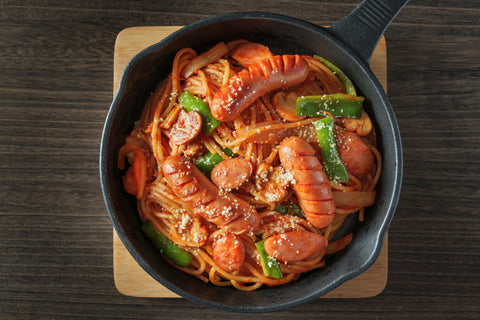
Napolitan, a Japanese take on spaghetti, combines pasta with a colorful medley of vegetables, sausages and ketchup-based sauce. Despite its Italian-inspired name, Napolitan is a quintessential Yoshoku creation, savored by kids and adults alike for its vibrant flavors.
If you’re a pasta lover and are curious about doing this version at home, why not give it a go with our Napolitan recipe?
Doria & Similar Yoshoku Forms
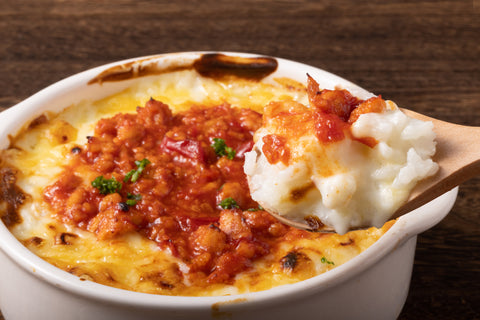
Doria takes inspiration from French gratin dishes, featuring a creamy rice casserole baked with a variety of toppings. Seafood, chicken, or vegetables are layered atop the rice, creating a comforting and gratifying dish.
In the same category as doria are guratan (gratin), risotto (a Japanese take on the Italian fave) and pirafu (you guessed it, Japanese rice pilaf).
Another Yoshoku item that’s made at home more often than consumed in restaurants is “shichu” – Japanese stew, but one that’s creamy white rather than brown (the latter is basically hayashi rice).
Korokke – Japanese Croquettes

Yoshoku's take on the croquette, Korokke, involves deep-frying a breaded patty typically made with mashed potatoes, ground meat and/or vegetables. Crispy on the outside and soft on the inside, Korokke is a popular snack and side dish in Japan.
Korokke is made at home, but can also be purchased at department store food halls and other restaurants (both dine-in and takeout).
Try your hand at korokke with our korokke recipe and tips!
Tonkatsu & Other “Furai” (Fried) Delights
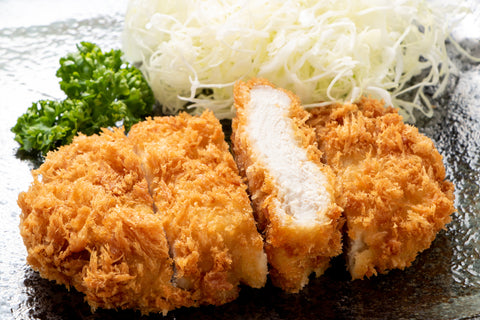
While Japan’s diet is generally seen as being healthy, it’s also true that Japanese people love their fried food!
Karaage (fried chicken) and tempura are considered “Washoku” or Japanese foods. But other fried foods, especially those deep-fried with a panko or breadcrumb coating, fall into the Yoshoku category.
These fried foods include the favorite tonkatsu, the deep-fried pork cutlet served with a tangy tonkatsu sauce.
In this category are other fried favorites such as ebi-furai (fried shrimp), kaki-furai (fried oysters), chicken tonkatsu, as well as menchi katsu (kind of like korokke but with the emphasis on the ground meat patty fried with flaky breading that’s golden brown. Another twist is the scotch egg, made with the same fried panko.
Hayashi Raisu (Hashed Beef Rice)
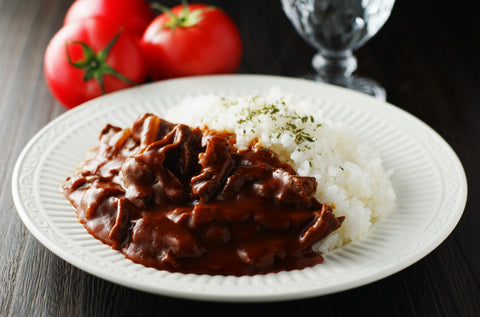
Inspired by European hashed beef stews, Hayashi Raisu is a Yoshoku dish featuring thinly sliced beef simmered in a demi-glace sauce with onions and mushrooms. Served over rice, this hearty and savory creation showcases the Japanese talent for elevating Western classics.
Yoshoku Beyond Japan’s Borders
If Yoshoku is an import that’s been adapted to Japanese tastes, then what would we call Yoshioku that exists in other countries? Not Washoku, no, it’s still Yoshoku but the kind that’s been reverse-exported.
Yoshoku's influence extends beyond Japan's borders, with various adaptations finding a global audience. Restaurants worldwide embrace Yoshoku-inspired dishes, recognizing the universal appeal of these creative culinary blends.
You can find Yoshoku virtually anywhere a sizable Japanese community exists. The aforementioned CoCo Ichibanya has curry outlets in the US and around Asia. Restaurants in California, NY and elsewhere dish out Yoshoku comfort food to Japanese expats as well as locals curious to try something other than sushi or ramen.
Is this Yoshoku Japanese? Is it Western? Yes to both!
Yoshoku And Culinary Innovation: The Future of Yoshoku

Yoshoku continues to evolve, with contemporary chefs pushing boundaries and creating new interpretations of classic dishes. The fusion of flavors, textures and presentation in Yoshoku reflects not only Japan's culinary creativity but also its penchant for embracing global influences.
While being “western” in origin, Yoshoku is a distinctly Japanese food category.
If you’re visiting Japan but are (understandably) looking to avoid western foods and want to focus solely on Japanese cuisine, consider Yoshoku as part of the latter – and include it on your meal schedule as you journey through Japan.
Do you have a favorite Yoshoku food? Have you tried making Yoshoku at home? We’d love to hear all about it!


0 comments